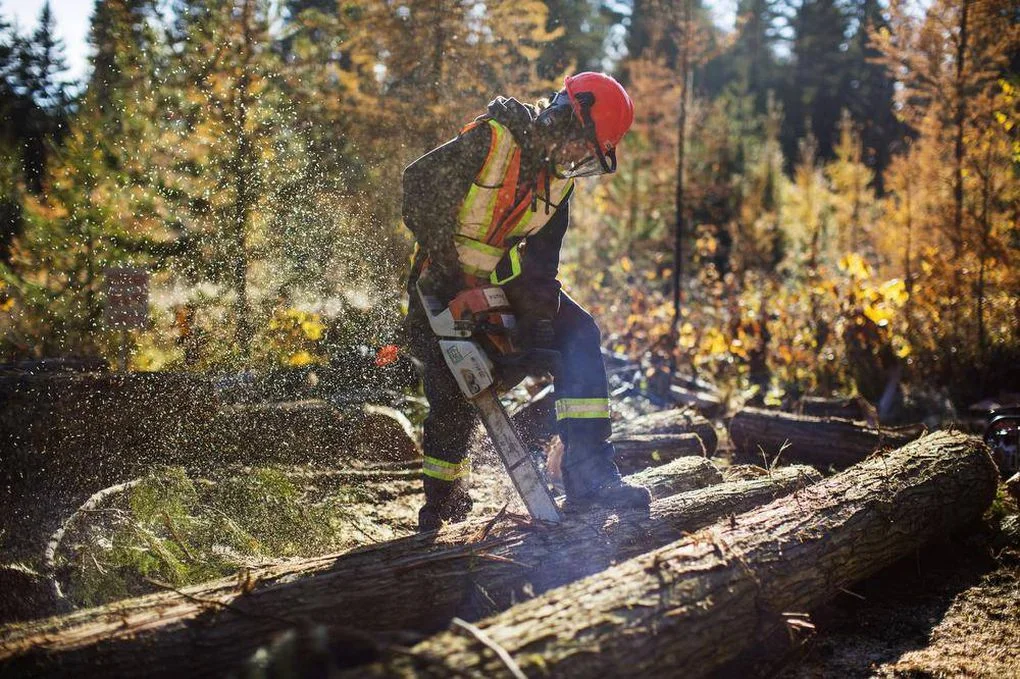Lumberjacks, Loggersports, and North American Forestry
Guest Post by MCFC Technical Intern Zach Bernard
Originally published July, 2019
Canada is a country of forests – 348 million ha dominating the landscape across the country, excluding the prairies and tundra. Its no surprise that when Europeans wanted to colonize North America, the forests needed to be harvested, cleared, and processed, which presented a great challenge. The bounty of North American forests was a double-edged sword – the seemingly infinite resource held massive pines, firs, oaks, and maples that could not easily be harvested. Coupled with the bug swarms, large predators, difficult terrain, and isolation North America proved a hostile place. Out of this demanding place was born a new breed of worker – the lumberjack.
Men in the logging camps lived to brave nature, and were very proud of their work and accomplishments. Reputations were built on a man’s strength, aggression, and hard work. Very few women were present in the camps, and a strong culture of defiance and rejection of modernity could be found in any one of those camps. Competitiveness was also a common theme, and men tried to best each other in any way possible – eating, drinking, wrestling, and of course, their work. Competitions were held both within camps and between them to find the best lumberjack of them all, decided through a variety of challenges; some obvious like chopping and sawing, others less obvious like a race to boil a can of water or beans.
In the early history of the US and Canada, loggers mostly came from Scandanavia, where they continued their cultural tradition of working in the woods. In this early time, lumberjacks worked in tight-knit crews and lived together in camps deep in the woods. Each man had a job, all were critical to the survival of the industry – and each other – and included whistle punk, high climber, faller, bucker, chaser, and choker setter. These jobs were extremely dangerous, low-paying, and mentally and physically exhausting. Even today the American Bureau of Labour Statistics ranks logging as one of the most dangerous jobs in the world. Despite this obvious risk, there were almost 500,000 lumberjacks in the forests of America in 1906. While the image of the lumberjack has been heavily romanticized in pop culture, it is quite close to the true character of these men of the woods.
After WWII, modern technology invaded logging camps. Men were replaced by machines and horses were replaced by skidders. Their tools were replaced by chainsaws and feller-bunchers, and modern industrial processes and regulations pervaded the lawless camps, which eventually became completely abolished by the adoption of access roads and automobiles. However, by no means did this spell the end of the lumberjack. Competitions, associations, and teams came into existence with the intention of preserving the culture and history of lumberjacks. Traditional tools were used to teach younger generations, and of course to compete. The lumberjack would live on into the modern era through these competitors and their new sport – most commonly known today as Loggersports.
University of New Brunswick Woodsmen team member (www.cilawoodsmen.ca)
Why does any of this matter to modern day forestry? Loggersports, and the men and women who partake in them represent the ideal face of the forest industry – embracing change and modern ideals, while keeping one foot in past. The 1950s and 60s brought great change to the forest industry; and industry that long resisted modern technology. To some extent, the forest industry is still resistant to change. In these days, however, it is mostly ideals and practices that are changing. One solution to this problem could be a return to the past; embracing old methods of forestry, combined with modern knowledge and techniques.
Germany is a great example of this; one of the leading countries in timber production, it employs nearly 1 000 000 people in it’s forest industry by focusing on small scale harvesting and processing. In comparison, Canada employs 195 000 people in our forestry industry – that’s 5 times more workers on approximately 1/30th the forested land base. In Germany, universities and industry players are innovating in areas like preventing loss of wood during milling, monitoring growth of trees, and ergonomic studies to reduce strain on chainsaw operators. Investing in similar practices in Canada would make working in our forests safer, more reliable, and more productive. More widely adopting sustainable, ecosystem-based harvesting practices could create jobs and increase our connection to the land and our forests. Experienced and knowledgeable forest workers can make smart decisions at a precise scale that still agree with broad management plans. Although in may be unfeasible in many cases, projects like the MCFC could achieve goals like environmentally sensitive management and community benefits by employing a more “lumberjack-based” workforce.
Student Chris Major, 16, who attends Charles Bloom high school in Lumby, B.C., runs a chainsaw as part of the school’s forestry program employing a more “lumberjack-based” workforce (Globe and Mail photo)
The lumberjack has a rich, respected history and a well-earned place in the story books of North America. Today, the spirit of the lumberjack lives on in the competitors of loggersports. Although his place in the past is well established, I believe the lumberjack will have a strong role to play in the future of our forests, as long as there is flannel to wear, beer to drink, and wood to chop.


